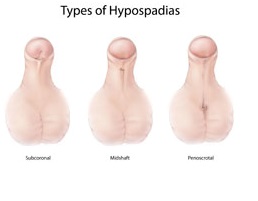Hypospadias Causes, Symptoms, Diagnosis and Treatment

What Is Hypospadias ?
A birth defect of the urethra, hypospadias in a male is characterized by the presence of the urinary opening on the head of the penis rather than the usual opening.
The second most common birth defect in boys, it tends to affect 1 child in every 250 children. Mostly the urinary opening is on the glans and is referred to as “distal hypospadias”.
A shiny tissue, called urethral plate, is prominent is such cases, which is observed to extend from the meatus to the tip of the glans.
Moreover, the foreskin may also be underdeveloped and may not wrap around the penis which may lead to the glans being left exposed.
Apart from causing distress, in most of the cases hypospadias does not cause any other complications.
There are three types of hypospadias which may depend upon the type and location of the defect. It includes:
- Subcoronal: The opening of the urethra is located somewhere near the head of the penis.
- Midshaft: The opening of the urethra is located along the shaft of the penis.
- Penoscrotal: The opening of the urethra is located where the penis and scrotum meet.
Causes Of Hypospadias:
The underlying cause of hypospadias is yet unknown. However, research regarding its cause is still ongoing. It may be inherited or be a result of some genetic mutation.
The mechanism is marked by malfunctioning in the action of the hormones which stimulate the formation of the urethra and the foreskin if the penis.
Possible risk factors may include:
- Age and weight of the mother
- An age of 35 years or older and mothers who are obese have a higher risk of having a baby with hypospadias
- Fertility treatments:
- There is a link between using assisted reproductive technology to help with pregnancy and hypospadias
- Certain hormones:
- Taking certain hormones just before or during pregnancy were linked to hypospadia
Symptoms Of Hypospadias:
The following symptoms are exhibited by affected infants:
- Opening of the urethra at a location other than the tip of the penis
- Downward curve of the penis
- Hooded appearance of the penis
- Abnormal spraying during urination
Diagnosis Of Hypospadias:
Hypospadias can be diagnosed via:
- Physical examination
- A sex determination evaluation, in severe cases
Treatment Of Hypospadias:
Some forms of hypospadias are very minor and do not require surgery. However, treatment usually involves surgery to reposition the urethral opening and, if necessary, straighten the shaft of the penis. Surgery is usually done between the ages of 6 and 12 months.
If the penis looks abnormal, circumcision should not be done. If hypospadias is found during circumcision, the procedure should be completed. In either case, referral to a pediatric urologist is recommended.
Surgery
Most forms of hypospadias can be corrected in a single surgery that’s done on an outpatient basis. Some forms of hypospadias will require more than one surgery to correct the defect.
When the urethral opening is near the base of the penis, the surgeon may need to use tissue grafts from the foreskin or from the inside of the mouth to reconstruct the urinary channel in the proper position, correcting the hypospadias.
Results of surgery
In most cases, surgery is highly successful. Most of the time the penis looks normal after surgery, and boys have normal urination and reproduction.
Occasionally, a hole (fistula) develops along the underside of the penis where the new urinary channel was created and results in urine leakage. Rarely, there is a problem with wound healing or scarring. These complications may require an additional surgery for repair.
By : Natural Health News




